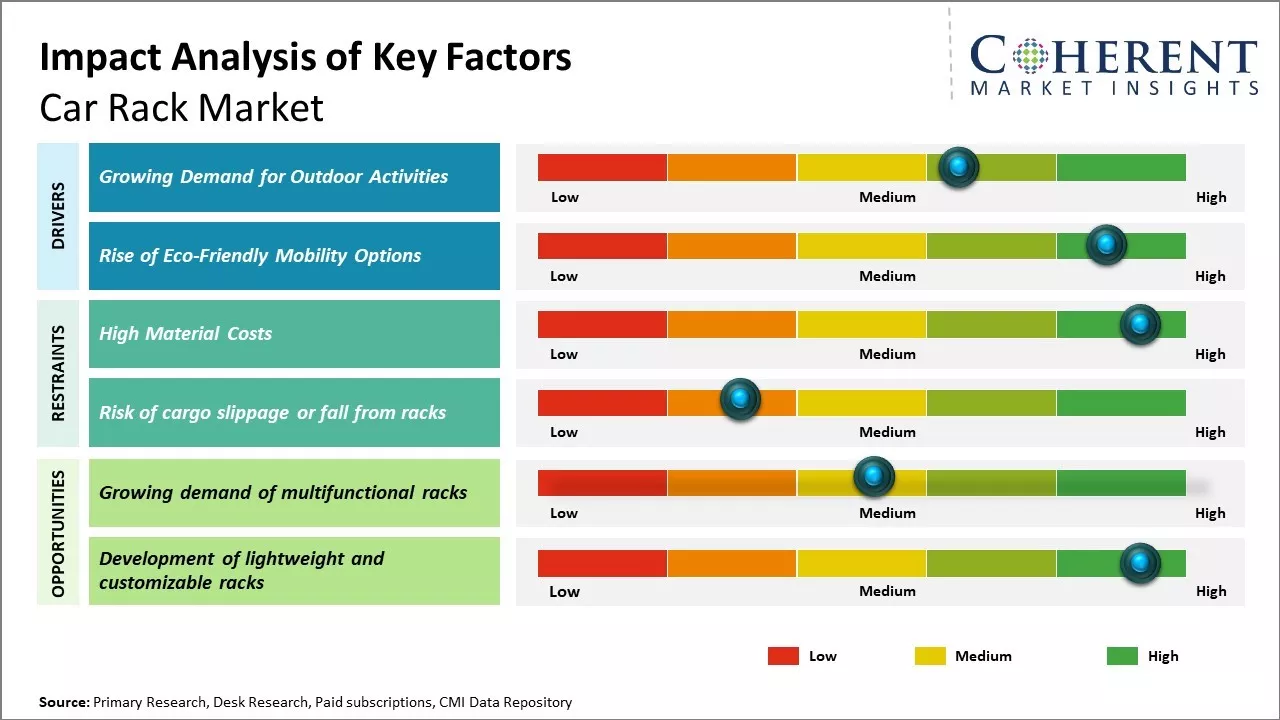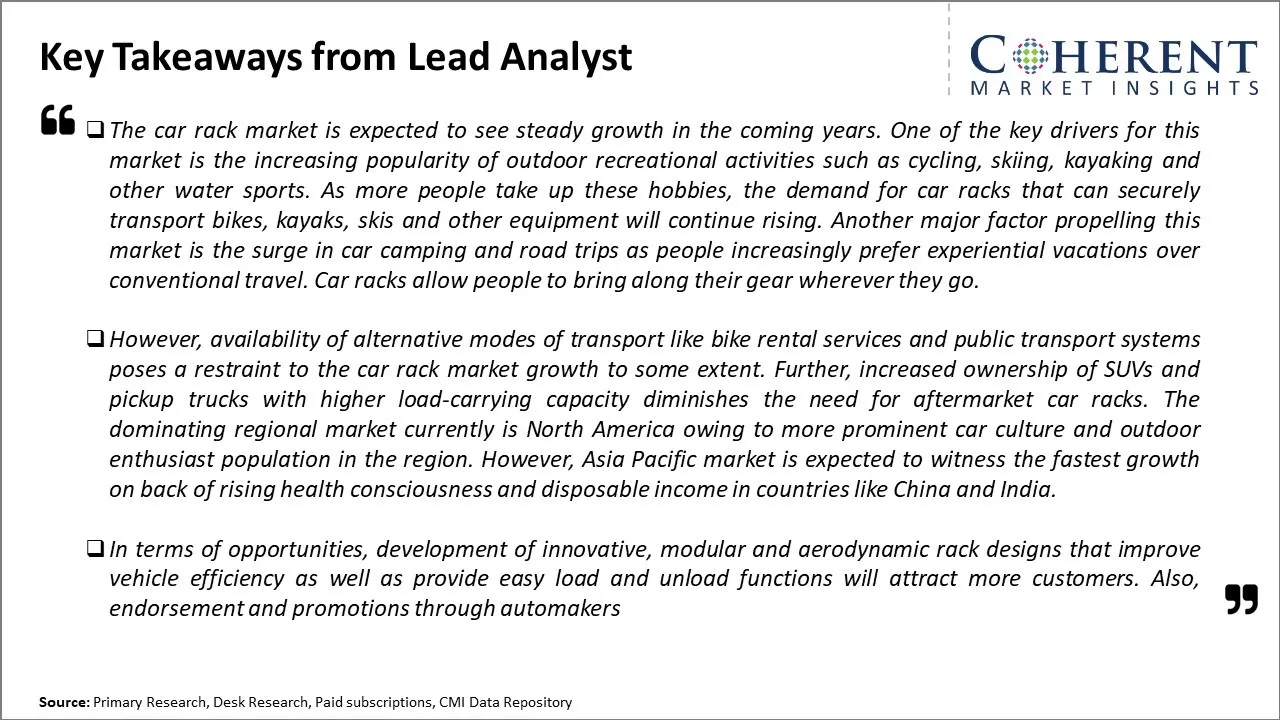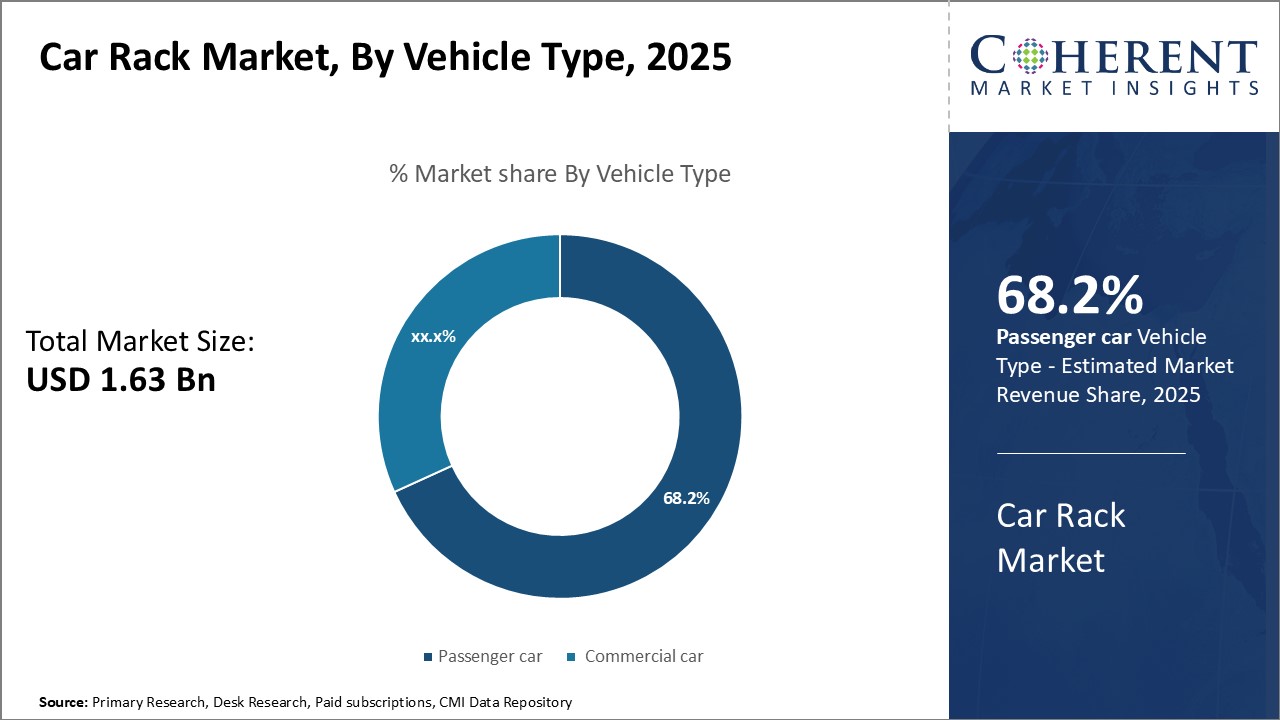The car rack market is estimated to be valued at US$ 1.63 Bn in 2025 and is expected to reach US$ 2.44 Bn by 2032, growing at a compound annual growth rate (CAGR) of 5.9% from 2025 to 2032.

Discover market dynamics shaping the industry: Request sample copy
The demand for car racks is growing due to the rising popularity of outdoor recreational activities. Car racks allow customers to conveniently transport their gear like bikes, kayaks, skis, etc. while traveling. Manufacturers are focusing on developing lightweight yet durable car racks with adjustable fittings to accommodate various vehicle types. New product additions like smart racks with theft protection features and ability to reserve space and pay online are gaining traction. While North America remains the largest market, Asia Pacific is expected to witness the fastest growth due to rising disposable incomes and interest of people in travel and adventure sports in countries like China, Japan, and India.
Market Drivers: Growing Demand for Outdoor Activities
The increasing popularity of outdoor recreational activities among consumers has created a robust demand for vehicle-mounted car racks. More people today seek outdoor adventures on weekends such as camping, hiking, cycling, skiing, or snowboarding trips. Car racks provide a convenient way for transporting bicycles, kayaks, surfboards, skis, and other sporting equipment to remote locations. As living standards rise, consumers have more disposable income to spend on leisure pursuits and thrill-seeking hobbies. The car rack market benefits immensely from this trend as outdoor adventure lover consumers need reliable racks to haul their gear safely and securely. Manufacturers are innovating with diverse rack designs specialized for different activity types to capitalize on the thriving outdoor recreation market.

Get actionable strategies to beat competition: Request sample copy
Rise of Eco-friendly Mobility OptionsWith growing environmental consciousness, electric bikes and scooters are gaining widespread popularity among urban populations as first and last mile solutions. These micro-mobility vehicles provide emissions-free transportation options within cities to commute shorter distances or for recreational use. However, it can be inconvenient to carry electric bikes and scooters into public transit or one's vehicle manually. Car racks specifically designed for electric bikes and scooters address this issue well. They securely fasten the vehicle to the car for easy multi-modal transit. As cities invest heavily to encourage eco-friendly commuting, the adoption of electric bikes and scooters will keep rising steadily. This underscores the undeniably strong growth prospects for micromobility-focused car rack variants. Leading rack brands offer appealing products catering to this burgeoning market by emphasizing their sustainable and space-saving characteristics.

To learn more about this report, Request sample copy
Market Challenges: High material costsCustomers are increasingly preferring multifunctional racks with versatility over single-use racks. Sustaining profit margins in the face of rising raw material costs is another challenge for manufacturers. Increased preferences for electric and hybrid vehicles also poses a threat as racks required are different. Further, the growing popularity of renting racks instead of purchases impacts long-term sales.
Market Opportunities: Growing demand of multifunctional racks
Rising popularity of outdoor recreational activities involving vehicles enables the scope for innovative racks. Increasing demand for racks suitable for different vehicle types and sizes expands the addressable market. New materials allowing durable yet lightweight constructions while maintaining affordability can attract more customers. Developing smart racks with features like theft-protection also opens possibilities.

Discover high revenue pocket segments and roadmap to it: Request sample copy
In terms of vehicle type, passenger car contributes the highest share of the market owing to convenience and versatilityThe passenger car segment holds the largest share in the car rack market owing 68.2% in 2025 primarily due to the rising preference for leisure travel activities. Car racks are increasingly being adopted by passenger vehicle owners to transport recreational gear like bicycles, surfboards, kayaks, skis and other sports equipment in a convenient and secure manner. Whether it is a family trip to the beach or mountains with sporting equipment, or daily commute with bicycles - roof or boot mounted racks allow hassle-free carrying of extra items.
Rising consumer incomes have fueled demand for adventure tourism and outdoor recreational activities. More people are taking up active hobbies like cycling, hiking, swimming etc. which has boosted the need for transportation of associated gear conveniently. Car racks come in variety of styles and loading capacities to match different vehicle models and cargo requirements. Their bolt-on external fitting facilitates quick installation and removal as per need, without cluttering interioe space. This versatility of usage is a key attraction.
Urbanization has also played a role, as limited living spaces in cities leave little room indoors to store sporting items. Car racks solve this problem by offering safe and weatherproof storage on the outdoor parts of the vehicle itself. High ownership of private vehicles, growing affordability and expanding road infrastructure in developing regions are additional factors strengthening sales in the passenger car segment.
Insights, By type, rail raised contributes the highest share, being easy to use and compatible with most vehicles
Based on type, rail raised racks have attained the maximum acceptance globally owing 31.7% 2025. These racks are mounted directly on top of the vehicle roof rails, which makes them very convenient to use. Most modern vehicles already come equipped with integrated roof rails as standard, facilitating hassle-free installation of rail mounted racks.
Rail raised racks allow loading of cargo parallel to the vehicle body instead of perpendicular loading with other rack types. This makes it aerodynamically more efficient resulting in better fuel economy. It also enables easy loading and unloading of items from the side without need for climbing atop vehicle. The racks can be quickly engaged or disengaged as per necessity, due to secure clamping mechanism on rails.
Rail mounted racks have a low lying, narrow profile which does not obstruct driver visibility or interfere with garage entry unlike some other designs. Their load bearing capacities are also adequate for most general and recreational cargo. An extensive aftermarket offers rail racks branded by established manufacturers as well universal fit accessories, ensuring availability and affordable pricing.

Need a Different Region or Segment? Customize now
North America has established itself as the dominant region owing 37.7% in 2025 in the global car rack market. The large size of the automotive industry and high vehicle ownership in countries like the U.S. have contributed significantly to the growth of this market. With people increasingly taking road trips and outdoor vacations, the demand for car racks to mount equipment like bikes, skis, kayaks, etc. on vehicles has surged tremendously over the years. Strong presence of key manufacturers like Thule, Yakima, and Rhino Rack has established North America at the forefront in car rack innovation as well. The pricing in the North American market also allows for higher profit margins compared to other regions.
One region that has emerged as the fastest growing market for car racks recently is Asia Pacific. With rising incomes and an expanding middle class, more people are buying vehicles and indulging in active outdoor pursuits. Countries like China, India, and Japan have a burgeoning market for recreational vehicles and equipment. Increasing exports from Asia Pacific has also bolstered the demand for commercial car racks used for cargo transportation. The presence of emerging manufacturing hubs and availability of raw materials at lower costs provide an edge to Asian manufacturers in this competitive industry. However, pricing pressures remain high in Asia Pacific due to the presence of local players and cost conscious consumers.
While Europe has been one of the major traditional markets for car racks, challenges remain. Stringent vehicle emission regulations have impacted growth to some extent. However, demand remains robust from countries such as Germany, France, and the U.K. due to high vehicle ownership and customer preference for premium brands. On the other hand, economic uncertainties in certain regions pose new challenges. Overall, factors like high spending power, innovation, and changing customer preferences will decide the future prospects of different regions in the global car rack market.
Car Rack Market Report Coverage
| Report Coverage | Details | ||
|---|---|---|---|
| Base Year: | 2024 | Market Size in 2025: | USD 1.63 Bn |
| Historical Data for: | 2020 To 2024 | Forecast Period: | 2025 To 2032 |
| Forecast Period 2025 to 2032 CAGR: | 5.9% | 2032 Value Projection: | USD 2.44 Bn |
| Geographies covered: |
|
||
| Segments covered: |
|
||
| Companies covered: |
Atera GmbH, Car Mate Mfg Co Ltd, Cequent, CRUZBER SA, Demar UK Ltd., Farad Pvt. Ltd., Front Runner GmbH, JAC Products, KAMEI GmbH and Co. KG, Kuat Innovations, Malone Auto Racks, Mont Blanc Group AB, Perrycraft Inc., Rhino Rack Pty Ltd., and Saris Equipment LLC |
||
| Growth Drivers: |
|
||
| Restraints & Challenges: |
|
||
Uncover macros and micros vetted on 75+ parameters: Get instant access to report
*Definition: The car rack market offers various racks and carriers that can be installed on vehicles to transport cargo on the roof, trunk, or tow hitch of cars. This includes roof racks that sit atop a vehicle to secure kayaks, canoes, bicycles, skis, and other equipment during travel. The market also provides cargo carriers that mount in the trunk or on the tow hitch of cars to haul luggage, boxes, gear, and other cargo more conveniently compared to placing them inside the vehicle.
Share
Share
About Author
Ameya Thakkar is a seasoned management consultant with 9+ years of experience optimizing operations and driving growth for companies in the automotive and transportation sector. As a senior consultant at CMI, Ameya has led strategic initiatives that have delivered over $50M in cost savings and revenue gains for clients. Ameya specializes in supply chain optimization, process re-engineering, and identification of deep revenue pockets. He has deep expertise in the automotive industry, having worked with major OEMs and suppliers on complex challenges such as supplier analysis, demand analysis, competitive analysis, and Industry 4.0 implementation.
Missing comfort of reading report in your local language? Find your preferred language :
Transform your Strategy with Exclusive Trending Reports :
Frequently Asked Questions
Joining thousands of companies around the world committed to making the Excellent Business Solutions.
View All Our Clients
US Reciprocal Tax Impact Analysis On Car Rack Market
Stay updated on tariff changes with expert insights and timely information